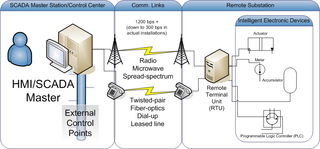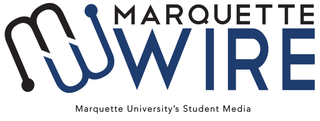Related Research Articles

Radio Televisión Martí is an American state-run radio and television international broadcaster based in Miami, Florida, financed by the federal government of the United States through the U.S. Agency for Global Media. It transmits news in Spanish to Cuba and its broadcasts can also be heard and viewed worldwide through their website and on shortwave radio frequencies.
Code of Federal Regulations, Title 47, Part 15 is an oft-quoted part of Federal Communications Commission (FCC) rules and regulations regarding unlicensed transmissions. It is a part of Title 47 of the Code of Federal Regulations (CFR), and regulates everything from spurious emissions to unlicensed low-power broadcasting. Nearly every electronics device sold inside the United States radiates unintentional emissions, and must be reviewed to comply with Part 15 before it can be advertised or sold in the US market.
In broadcast engineering, a remote broadcast is broadcasting done from a location away from a formal television studio and is considered an electronic field production (EFP). A remote pickup unit (RPU) is usually used to transmit the audio and/or video back to the television station, where it joins the normal airchain. Other methods include satellite trucks, production trucks and even regular telephone lines if necessary.
A remote pickup unit or RPU is a radio system using special radio frequencies set aside for electronic news-gathering (ENG) and remote broadcasting. It can also be used for other types of point-to-point radio links.
Radio jamming is the deliberate jamming, blocking or interference with wireless communications. In some cases, jammers work by the transmission of radio signals that disrupt communications by decreasing the signal-to-noise ratio.
Indigenous Community Television (ICTV) is an Australian free-to-view digital television channel on the Viewer Access Satellite Television service. It broadcasts television programs produced by, and for, Indigenous Australians in remote communities. The channel is owned by membership-based company Indigenous Community Television Limited. Although ICTV is a community television channel by name and content, it broadcasts using an open-narrowcast licence instead of a standard community television licence.

Distributed Network Protocol 3 (DNP3) is a set of communications protocols used between components in process automation systems. Its main use is in utilities such as electric and water companies. Usage in other industries is not common. It was developed for communications between various types of data acquisition and control equipment. It plays a crucial role in SCADA systems, where it is used by SCADA Master Stations, Remote Terminal Units (RTUs), and Intelligent Electronic Devices (IEDs). It is primarily used for communications between a master station and RTUs or IEDs. ICCP, the Inter-Control Center Communications Protocol, is used for inter-master station communications. Competing standards include the older Modbus protocol and the newer IEC 61850 protocol.
A television station is a set of equipment managed by a business, organisation or other entity, such as an amateur television (ATV) operator, that transmits video content and audio content via radio waves directly from a transmitter on the earth's surface to any number of tuned receivers simultaneously.
WJWA is a radio station in Evansville, Indiana. It is a noncommercial station owned and operated by Hope Media Group, broadcasting their WAY-FM Network programming.
A network socket is a software structure within a network node of a computer network that serves as an endpoint for sending and receiving data across the network. The structure and properties of a socket are defined by an application programming interface (API) for the networking architecture. Sockets are created only during the lifetime of a process of an application running in the node.
Marti may refer to
A POTS codec is a type of audio coder-decoder (codec) that uses digital signal processing to transmit audio digitally over standard telephone lines at a higher level of audio quality than the telephone line would normally provide in its analog mode. The POTS codec is one of a family of broadcast codecs differentiated by the type of telecommunications circuit used for transmission. The ISDN codec, which instead uses ISDN lines, and the IP codec which uses private or public IP networks are also common.
Remote is a 1993 American comedy film that was released directly to video on September 22, 1993 by Paramount Pictures through Moonbeam Entertainment. It stars Chris Carrara, Jessica Bowman, and John Diehl. Ted Nicolaou directed the films and it was written by Mike Farrow, best known for his hard-boiled detective persona Tommy Sledge. It is the second film to be released by Moonbeam Entertainment, following Prehysteria! (1993).

Broadcast Electronics (BE) is a manufacturer of AM and FM transmitters, Marti Electronics STL and RPU equipment, developer of the AudioVAULT radio automation system and parent company to Commotion - a social media company for radio.

Radio is the technology of signaling and communicating using radio waves. Radio waves are electromagnetic waves of frequency between 30 hertz (Hz) and 300 gigahertz (GHz). They are generated by an electronic device called a transmitter connected to an antenna which radiates the waves, and received by another antenna connected to a radio receiver. Radio is very widely used in modern technology, in radio communication, radar, radio navigation, remote control, remote sensing, and other applications.

Marquette Wire is the official outlet of Marquette University's student media, supported by the university's Diederich College of Communication, which allows students to gain real-world experience in producing mainstream media. Students studying journalism, digital media and other related fields can gain experience through writing, editing, producing and publishing content relating to Marquette and the surrounding Milwaukee community.

91.7 WCUC FM is a fully operational, FCC-licensed, non-commercial educational, student-run radio station under the Department of Communication that is operated with the intention of being a student learning lab for Clarion University of Pennsylvania.

A television production truck or OB van is a small mobile production control room to allow filming of events and video production at locations outside a regular television studio. They are used for remote broadcasts, outside broadcasting (OB), and electronic field production (EFP). Some require a crew of as many as 30 people, with additional trucks for additional equipment as well as a satellite truck, which transmits video back to the studio by sending it up through a communications satellite using a satellite dish, which then transmits it back down to the studio. Alternatively, some production trucks include a satellite transmitter and satellite dish for this purpose in a single truck body to save space, time and cost.

Remote recording, also known as location recording, is the act of making a high-quality complex audio recording of a live concert performance, or any other location recording that uses multitrack recording techniques outside of a recording studio. The multitrack recording is then carefully mixed, and the finished result is called a remote recording or a live album. This is in contrast to a field recording which uses few microphones, recorded onto the same number of channels as the intended product. Remote recording is not the same as remote broadcast for which multiple microphones are mixed live and broadcast during the performance, typically to stereo. Remote recording and remote broadcast may be carried out simultaneously by the same crew using the same microphones.
Northern Access Network was a Canadian unlicensed television system which broadcast videotaped programming to remote Canadian communities in the late 1970s. Although short-lived and often in conflict with the Canadian Radio-television and Telecommunications Commission over its lack of a broadcast license, the service did have the effect of forcing Canada's major commercial television networks to add rebroadcast transmitters in a number of communities they had previously ignored.
References
- ↑ Fitch, Charles (2005-05-25). "This Pot Reserved for Marti Remote". Radio World.